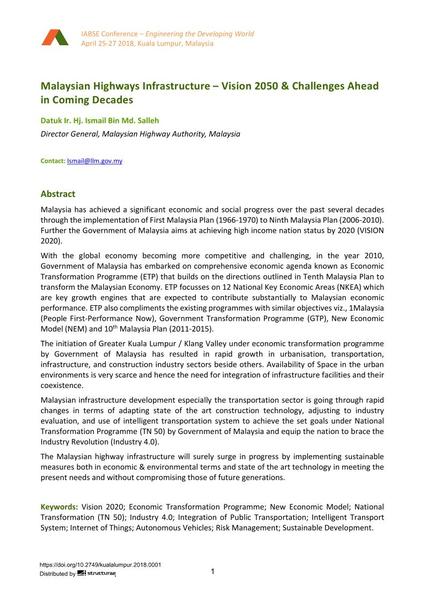Malaysian Highways Infrastructure – Vision 2050 & Challenges Ahead in Coming Decades

|
|
|||||||||||
Bibliographic Details
| Author(s): |
Ismail Md Salleh
(Director General, Malaysian Highway Authority, Malaysia)
|
||||
|---|---|---|---|---|---|
| Medium: | conference paper | ||||
| Language(s): | English | ||||
| Conference: | IABSE Conference: Engineering the Developing World, Kuala Lumpur, Malaysia, 25-27 April 2018 | ||||
| Published in: | IABSE Conference Kuala Lumpur 2018 | ||||
|
|||||
| Page(s): | 1-8 | ||||
| Total no. of pages: | 8 | ||||
| DOI: | 10.2749/kualalumpur.2018.0001 | ||||
| Abstract: |
Malaysia has achieved a significant economic and social progress over the past several decades through the implementation of First Malaysia Plan (1966-1970) to Ninth Malaysia Plan (2006-2010). Further the Government of Malaysia aims at achieving high income nation status by 2020 (VISION 2020). With the global economy becoming more competitive and challenging, in the year 2010, Government of Malaysia has embarked on comprehensive economic agenda known as Economic Transformation Programme (ETP) that builds on the directions outlined in Tenth Malaysia Plan to transform the Malaysian Economy. ETP focusses on 12 National Key Economic Areas (NKEA) which are key growth engines that are expected to contribute substantially to Malaysian economic performance. ETP also compliments the existing programmes with similar objectives viz., 1Malaysia (People First-Performance Now), Government Transformation Programme (GTP), New Economic Model (NEM) and 10th Malaysia Plan (2011-2015). The initiation of Greater Kuala Lumpur / Klang Valley under economic transformation programme by Government of Malaysia has resulted in rapid growth in urbanisation, transportation, infrastructure, and construction industry sectors beside others. Availability of Space in the urban environments is very scarce and hence the need for integration of infrastructure facilities and their coexistence. Malaysian infrastructure development especially the transportation sector is going through rapid changes in terms of adapting state of the art construction technology, adjusting to industry evaluation, and use of intelligent transportation system to achieve the set goals under National Transformation Programme (TN 50) by Government of Malaysia and equip the nation to brace the Industry Revolution (Industry 4.0). The Malaysian highway infrastructure will surely surge in progress by implementing sustainable measures both in economic & environmental terms and state of the art technology in meeting the present needs and without compromising those of future generations. |
||||
| Keywords: |
risk management sustainable development Internet of Things (IOT) Vision 2020 Economic Transformation Programme New Economic Model National Transformation (TN 50) Industry 4.0 Integration of Public Transportation Intelligent Transport System Autonomous Vehicles Internet of Things
|
||||
